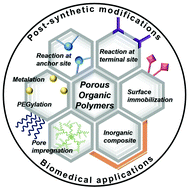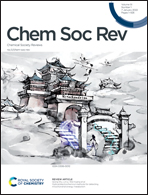Post-synthetic modifications in porous organic polymers for biomedical and related applications
Abstract
Porous organic polymers (POPs) are prepared by crosslinked polymerization of multidimensional rigid aromatic building blocks. Generally, POPs can be classified into crystalline covalent organic frameworks (COFs) and other poorly crystalline or amorphous porous polymers. Due to their remarkable intrinsic properties, such as high porosity, stability, tunability, and presence of numerous building blocks, several new POPs are being developed for application across various scientific fields. The essential sensitive functional groups needed for specific applications are not sustained under harsh POP preparation conditions. The recently developed post-synthetic modification (PSM) strategies for POPs have enabled their advanced applications that are otherwise restricted. Owing to the advanced PSM strategies POPs have experienced a blossoming resurgence with diverse functions, particularly in biomedical applications, such as bioimaging tools, drugs, enzymes, gene or protein delivery systems, phototherapy, and cancer therapy. This tutorial review focuses on the recently developed PSM strategies for POPs, especially for biomedical applications, and their future perspectives as promising bioapplicable materials.

- This article is part of the themed collection: Future Applications and Techniques using Porous Organic Polymers


 Please wait while we load your content...
Please wait while we load your content...